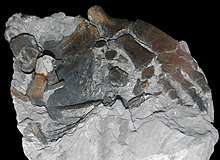Atocetus
Atocetus is an extinct genus of pontoporiid dolphin found in Miocene-age marine deposits in Peru and California.[1]
| Atocetus | |
|---|---|
| Skull of A. iquensis | |
| Scientific classification | |
| Kingdom: | Animalia |
| Phylum: | Chordata |
| Class: | Mammalia |
| Order: | Artiodactyla |
| Infraorder: | Cetacea |
| Family: | †Kentriodontidae |
| Subfamily: | †Pithanodelphininae |
| Genus: | †Atocetus De Muizon 1988 |
| Species | |
| |
Description

The type species, Atocetus iquensis, is known from Serravallian-age strata of the Pisco Formation of Peru,[2] while A. nasalis is known from Tortonian-age marine deposits in California.[3] Barnes (1985) originally described the latter as a species of Pithanodelphis, but it was eventually transferred to Atocetus by Muizon (1988). The Miocene delphinidan "Champsodelphis" fuchsii from marine deposits in Austria was initially tentatively referred to Atocetus based on the discovery of partial skeletons from the Carpathian region with earbones similar to those of Atocetus but was eventually re-assigned to Kentriodon following the discovery of additional earbones from Austria and Romania.[4][5]
Phylogeny
Although Atocetus and other pithanodelphinines are usually assigned to Kentriodontidae, the cladistic analysis of Lambert et al. (2017) showed that Atocetus and Pithanodelphis form a clade with Tagicetus and Lophocetus that is not only phylogenetically more derived than other kentriodontids but is also phylogenetically intermediate between the baiji and members of Inioidea and Phocoenidae.[6] However, a subsequent cladistic analysis by Post et al. (2017) recovers Atocetus as a member of Pontoporiidae, which includes the franciscana.[7]
References
- Ichishima, H.; Barnes, L. G.; Fordyce, R. E.; Kimura, M.; Bohaska, D. J. (1994). "A review of kentriodontine dolphins (Cetacea; Deiphinoidea; Kentriodontidae): Systematics and biogeography". The Island Arc. 3 (4): 486. doi:10.1111/j.1440-1738.1994.tb00127.x.
- De Muizon, 1988, p.131
- L. G. Barnes. 1985. The Late Miocene dolphin Pithanodelphis Abel, 1905 (Cetacea: Kentriodontidae) from California. Contributions in Science 367:1-27.
- E. Kazár, M. Vremir, and V. Codrea. 2004. Dolphin remains (Cetacea: Odontoceti) from the middle Miocene of Cluj-napoca, Romania. Acta Paleontologica Romanie 4:179-189.
- E. Kazár. 2006. Odontocete periotics (Mammalia: Cetacea) from the Carpathian Basin, Middle Miocene (Badenian and Sarmatian Stages), including the Vienna Basin, Austria. Beitrage zur Palaontologie 30:269-292.
- Olivier Lambert, Giovanni Bianucci, Mario Urbina, Jonathan H. Geisler; A new inioid (Cetacea, Odontoceti, Delphinida) from the Miocene of Peru and the origin of modern dolphin and porpoise families. Zool J Linn Soc 2017; 179 (4): 919-946. doi: 10.1111/zoj.12479
- Post K, Louwye S, Lambert O. (2017) Scaldiporia vandokkumi, a new pontoporiid (Mammalia, Cetacea, Odontoceti) from the Late Miocene to earliest Pliocene of the Westerschelde estuary (The Netherlands) PeerJ 5:e3991 https://doi.org/10.7717/peerj.3991
Bibliography
- De Muizon, C. 1988. Les Vertébrés fossiles de la Formation Pisco (Pérou). Troisième partie: Les Odontocètes (Cetacea, Mammalia) du Miocène. Editions Recherche sur les Civilisations 78. 1–244. Accessed 2019-03-13.